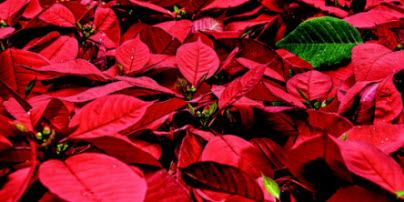Perhaps it seems a little early to be talking poinsettias, but not if you’ve carefully nurtured the beauty you got last Christmas. You got it through the spring, giving it a light holiday outside over the summer, fertilizing it during its growing period. It’s full and green and happy, but you are longing to see those bright red bracts once again. So now what?
You need to withdraw light from your poinsettia for 13 to 16 hours, providing it with complete darkness for the next 40 days. Be diligent. No light can leak into the darkness or it may affect the photoperiodicity and stop the bloom. After the plant has had the recommended number of dark hours, it needs bright daylight, preferably at temperatures around 18°C (the darkness temperature should be about three degrees lower).
To keep the plant dark, you can cover it with a cardboard box or hide it in a dark closet. Do this as the day wanes and wake it up before you go to work the next morning. As the colour begins to return to its leaves, you can give it fewer hours of darkness and more water. Be sure to let the water flow through the pot. Poinsettias (as you probably already know having brought it though a whole year) do not like to be in soggy conditions or to have wet feet.
If bringing a poinsettia back to bloom is still in your future, then this year after Christmas, when the blooms begin to fail, withdraw bright light and watering, just giving the plant enough water to keep it alive. Leaves will fall off and that’s okay. You can even cut the stems back to about three inches from the top of the soil. The poinsettia is resting. As long at the stem stumps stay green, all is right with the world. Brown, dry stems means give up, it’s dead.
As the days get longer in late-February and early-March, or as soon at the plant begins to show signs of life and throws out new leaves, move it back to a brighter location, increase the watering and start fertilizing. When you begin fertilizing, be sure the plant is getting enough light to make use of the fertilizer. You may even want to wait until April to start this regimen.
In late-May or early-June, when all danger of frost is behind us, you can repot the plant into one that is two or three inches larger, then take it outside to a sheltered, somewhat shady sport. Dappled shade under a tree canopy is the best. You can continue to fertilize until mid- or late-July.
When buying a poinsettia, look at the centre of the red bract where you will find the little yellow flowers. Buy the plant with the flowers still tightly closed, as your red bracts (actually leaves) will last longer.
Keep the plant out of drafts, as it will drop leaves if you don’t. In fact, many people allow their poinsettia to get chilled on the way home from buying it and then wonder why it is losing branches. They are very sensitive to cold. Remember, poinsettias are from Mexico. Place the plant in a warm, bright spot. Give the cyclamen you bought, the drafty location in the darker living room.
If you are on a budget (or even if you are not), here’s a tip. Instead of buying the big $50 plant, look for three cheaper ones and place them together in a wicker basket with a nice tartan bow on the handle. Don’t bother fertilizing the flowering plants — that is done during the growing period, not the flowering one. Use a balanced fertilizer (all three numbers the same) and your plant will be fine.
When watering, take the plant to the sink and water thoroughly, but let the water run through as mentioned above. Overwatering and soggy soil will shorten the plant’s life.



